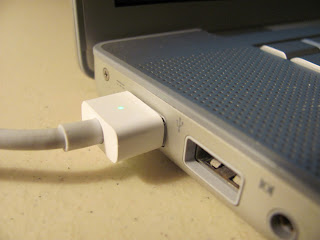 |
| This gory carnage brought to you by http://en.wikipedia.org/wiki/MagSafe |
The MagSafe revolutionized laptop recharger connection port safety with the brilliant innovation of a magnetic connection between port and connector. But how would such an invention work?
 |
| Before I answer the question, a few action shots. |
 |
| Always practice safe charging. |
Therefore, the only plausible construction of the MagSafe would be for either the port or the connector to be magnetically charged, and the other made of an uncharged yet ferromagnetic material. And by 'ferromagnetic material,' I mean a material that contains atoms with elections that have unpaired spins that create domains that align when in the presence of a stronger magnet.
But which one is the magnet, and which is merely the ferromagnetic material? Well...
 |
| A few paper clips enhance my understanding. |
This makes sense, because if the connector was a magnet, it could pick up many bits of ferromagnetic material and create the potential for a short circuit. But short circuits are from another chapter.